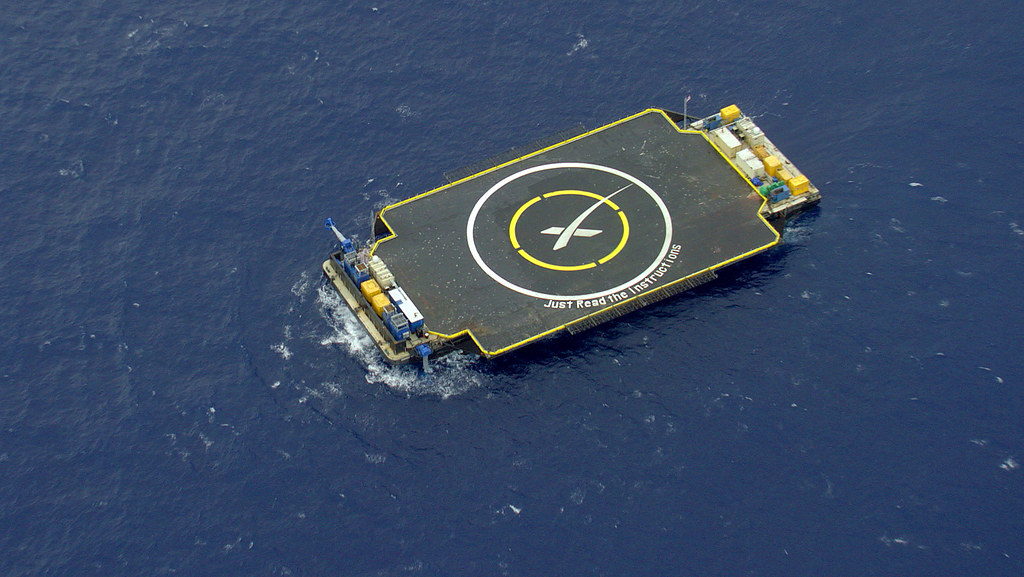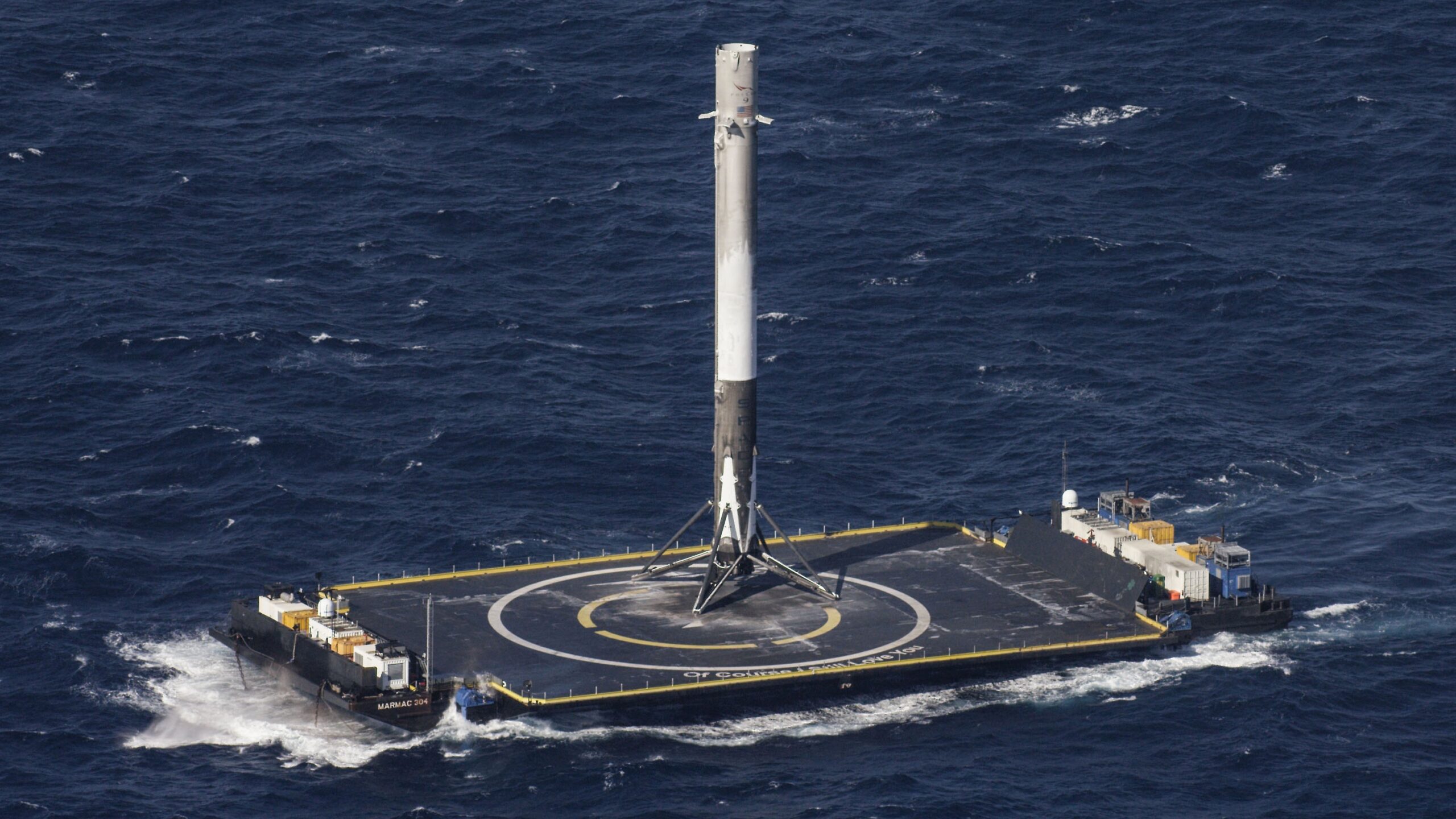Landing on a drone ship has become SpaceX’s signature move. This elegant solution transformed rocket recovery from a rare spectacle into a routine operation. It has drastically cut costs, saved time, and reshaped the very rhythm of spaceflight. Now, with the rise of Starship, this proven method is set to scale like never before. Official plans from SpaceX and the FAA point to a future where Starship 2 will descend on ocean platforms, pushing the dream of full reusability even further.
But how exactly will this method unlock Starship’s true potential? And when can we expect to see it in action? Let’s dive deep into this revolutionary aspect of spaceflight.
The Rise of Drone Ship Landings: From Falcon 9 to Starship
SpaceX’s journey with drone ship landings began with Falcon 9 and Falcon Heavy rockets. This innovative approach allowed boosters to return safely to the ocean, avoiding the risks associated with land-based recoveries.
Why drone ships? Landing at sea offers several crucial advantages. First, it improves safety—the ocean acts as a natural buffer against heat, force, and vibration, reducing risk to personnel and infrastructure. Second, it helps preserve the rocket’s structure by reducing stress upon landing, which lowers repair costs. Third, drone ships offer flexibility—they can be positioned almost anywhere along a launch trajectory, enabling optimized return paths and reduced fuel consumption. Scaling this success to the much larger Starship promises even greater operational benefits.
Ambitious Launch Cadence Demands Refined Recovery Methods
Starship’s test flights have shown rapid progress, supported by ambitious future plans. Official proposals suggest:
- 44 flights per year from Launch Complex 39A (LC39A)
- 25 annually from Starbase
- Up to 76 from Space Launch Complex 37 (SLC-37) in Florida
Such a high launch cadence demands more than just fast production and turnaround; the logistics of recovery and landing must be equally efficient.

SpaceX plans to use two primary recovery methods for Starship:
- Mechazilla Tower Arms: Fixed, land-based towers that “catch” Starship during descent, enabling rapid refurbishment and high launch frequency.
- Drone Ship Landings: Mobile platforms offering flexibility for long-distance missions where landing infrastructure doesn’t exist.
These two methods complement rather than compete with each other—Mechazilla enables rapid turnarounds at fixed bases, while drone ships provide flexibility and safety for distant ocean landings.
Starship Drone Ship Landings: The Next Frontier
According to FAA and SpaceX documents, Starship drone ship landings will extend operational reach beyond coastal zones into the Pacific and Indian Oceans.
Unlike earlier splashdown techniques that damage rockets and slow refurbishment, SpaceX aims to avoid water impact entirely, favoring controlled landings on drone ships to ensure fast, efficient reuse.
Key Benefits of Drone Ship Landings for Starship
- Enhanced Payload Capacity: Less fuel reserved for returning to a fixed base means more fuel can be used for payloads and longer mission ranges.
- Increased Safety: Ocean landings reduce risks to people and property.
- Greater Mission Flexibility: Drone ships can be strategically positioned, enabling optimized recovery.
Scaling these advantages to Starship, which is much larger than Falcon 9, will require specially designed drone ships capable of handling immense size and thrust.
Challenges Ahead: International Cooperation and Logistics
While drone ships operate in international waters, many recovery missions will require access to exclusive economic zones or territorial waters of other countries. Securing regulatory approvals and diplomatic agreements will be crucial. SpaceX is already working on this, having secured permissions near the Bahamas and holding talks for collaborations near Australia and South America.
Another challenge is recovery time. Positioning drone ships far offshore means recovery vessels could take days to return to port, potentially slowing refurbishment cycles. SpaceX may address this through “horizontal Starship delivery” — lowering the rocket from vertical to horizontal for safer transport on rough seas — and other advanced logistics procedures.
Engineering Considerations: Deployable Landing Legs and Structural Challenges
Unlike Mechazilla towers, drone ships cannot catch Starship mid-air. Starship will need deployable landing legs for ocean platform touchdowns, adding complexity to the design. However, these legs are critical for future lunar and Martian surface landings where no catch towers will exist. Developing this capability now supports SpaceX’s broader ambitions for planetary exploration.
Scaling Up Infrastructure: Building Starship’s Drone Ship Fleet
To support Starship, SpaceX must build larger, structurally reinforced drone ships capable of safely recovering a vehicle more than twice the height and mass of Falcon 9. These ships must handle immense thrust and weight, offer stability during rough seas, and possibly support multiple recoveries before returning to port.
At the same time, ground facilities are scaling up with new launch pads and production hangars. Pad B and massive upgrades are underway at Starbase, and new platforms are planned at LC39A and SLC-37, supported by large “gigabays” for high-volume manufacturing.
Falcon 9: A Record-Breaking Foundation for Starship
Falcon 9’s drone ship landings have proven this method’s reliability and efficiency. Notably, booster B1067 landed for the 29th time on the drone ship A Shortfall of Gravitas, setting a record for orbital-class rocket reusability. Falcon 9 recently completed its 500th mission, unmatched by any other rocket. With over 170 planned launches for 2025, this rapid cadence is only possible because of reusability and drone ship recovery.
These milestones highlight how critical drone ship landings are to SpaceX’s success and point toward Starship’s promising future.
When Can We Expect Starship Drone Ship Landings?
Based on current indicators, drone ship landings for Starship will likely begin in the second half of 2026. Starship’s rapid launch cadence still faces hurdles, including ongoing infrastructure construction and vehicle refinement. Initially, SpaceX will focus on Mechazilla tower landings for data collection and operational consistency. Once stable, the drone ship system will expand Starship’s operational reach.
The Future: A New Chapter in Spaceflight Reusability
Starship drone ship landings represent a major leap beyond Falcon 9’s achievements, unlocking greater mission flexibility, expanded recovery zones, and faster turnaround on long-distance missions.
Despite challenges, SpaceX’s vision points to a future where drone ships become essential to the world’s highest frequency spaceflight system.
Conclusion: A Revolution in Rocket Recovery
Drone ship landings are not just a logistical convenience — they are central to SpaceX’s goal of full rocket reusability and sustainable spaceflight. When the first Starship finally touches down on a floating landing pad, it will mark a technological revolution, the birth of a new era in exploration, and a pathway toward the moon, Mars, and beyond.
What are your thoughts on Starship drone ship landings? Share your opinions in the comments below!
FAQs
1. What is a drone ship landing?
A drone ship landing is a method where a rocket booster or spacecraft lands on a large, autonomous ocean platform instead of returning to a land-based pad. This technique increases safety and flexibility in rocket recovery.
2. Why does SpaceX use drone ships for rocket landings?
SpaceX uses drone ships to safely recover rockets at sea, reducing risk to people and infrastructure, enabling more efficient fuel use, and allowing landings farther downrange for certain missions.
3. When will SpaceX start landing Starship on drone ships?
According to FAA announcements and SpaceX plans, Starship is expected to begin drone ship landings around the second half of 2026.
4. How do drone ship landings benefit Starship compared to land landings?
Drone ship landings offer greater flexibility by allowing Starship to land farther from the launch site, conserve fuel, and reduce stress on the vehicle, especially for long-distance missions.
5. What challenges does SpaceX face with Starship drone ship landings?
Challenges include building larger, reinforced drone ships, securing international permissions for ocean landings, adapting recovery logistics, and engineering deployable landing legs for Starship.
6. What is Mechazilla, and how does it relate to drone ship landings?
Mechazilla is SpaceX’s robotic “catching” tower system for catching Starship boosters at fixed land sites. It complements drone ship landings by enabling rapid turnaround at launch bases.
7. How does landing on a drone ship improve rocket reusability?
Landing on drone ships minimizes vehicle damage by providing a softer ocean buffer and allows faster recovery and refurbishment, critical for SpaceX’s goal of full reusability.
8. Are drone ship landings safer than land-based landings?
Yes, ocean landings reduce the risk to nearby infrastructure and people, acting as a natural buffer against landing stresses and potential failures.
9. How many drone ships does SpaceX currently operate?
As of now, SpaceX operates two drone ships on the East Coast and one on the West Coast, primarily for Falcon 9 landings.
10. Will Starship drone ships be different from Falcon 9 drone ships?
Yes, Starship drone ships will be significantly larger and structurally reinforced to accommodate Starship’s larger size, mass, and powerful engines.
11. What is the expected launch cadence for Starship?
SpaceX plans an ambitious cadence: up to 44 flights per year from LC39A, 25 from Starbase, and 76 from SLC-37, supported by rapid recovery methods including drone ship landings.
12. How does SpaceX plan to transport Starship safely from drone ships to land?
SpaceX plans to use a “horizontal Starship delivery” method, lowering the rocket from vertical to horizontal after landing to simplify transport and protect the vehicle from rough seas.
13. Why is international cooperation important for drone ship landings?
Many drone ship landing zones lie in or near the territorial waters of other nations, requiring diplomatic agreements and regulatory approval to legally recover rockets.
14. How does drone ship recovery support SpaceX’s goals for moon and Mars missions?
Drone ship landings with deployable legs will simulate future planetary landings where infrastructure doesn’t exist, making ocean recoveries a crucial step toward lunar and Martian exploration.
15. How has Falcon 9’s drone ship success influenced Starship’s recovery plans?
Falcon 9’s proven drone ship landings have demonstrated the reliability and efficiency of sea recovery, providing a solid foundation for scaling the system to the larger and more capable Starship.
Read More:
- INSANE 1,968-Mile Battery Shocks Elon Musk with 5 Min Charge! Destroy All EV Industry
- Neuralink Reveals New BLINDSIGHT Implant
- Why Is SpaceX Starship So Difficult to Get Right? Is this even possible?
- Why Tesla’s Q3 could be one of its biggest quarters in history
- Tesla Model 3 ranks as the safest new car in Europe for 2025, per Euro NCAP tests


1 thought on “FAA officially announced SpaceX Landing both Starship and Booster on DRONESHIP in 2026”